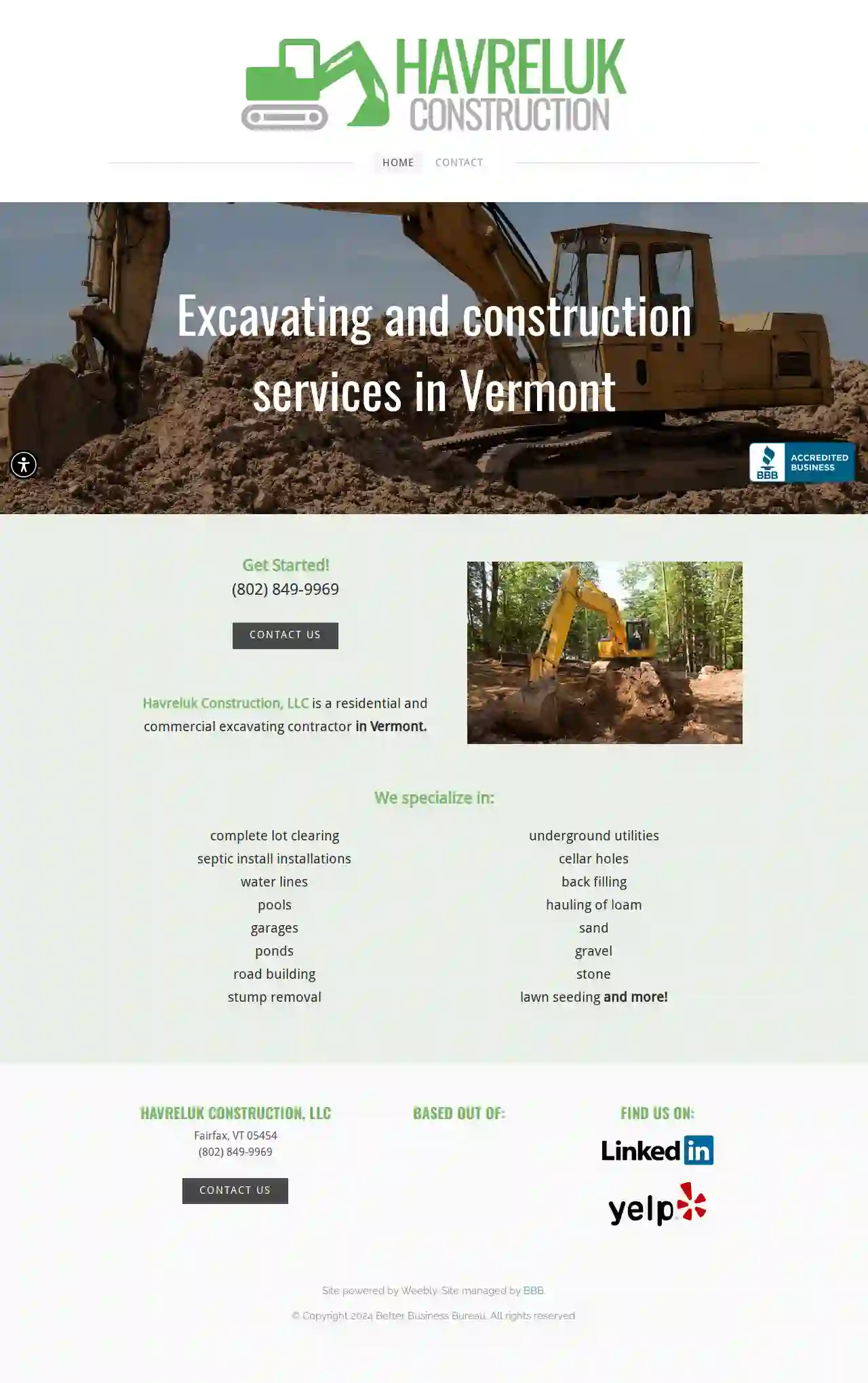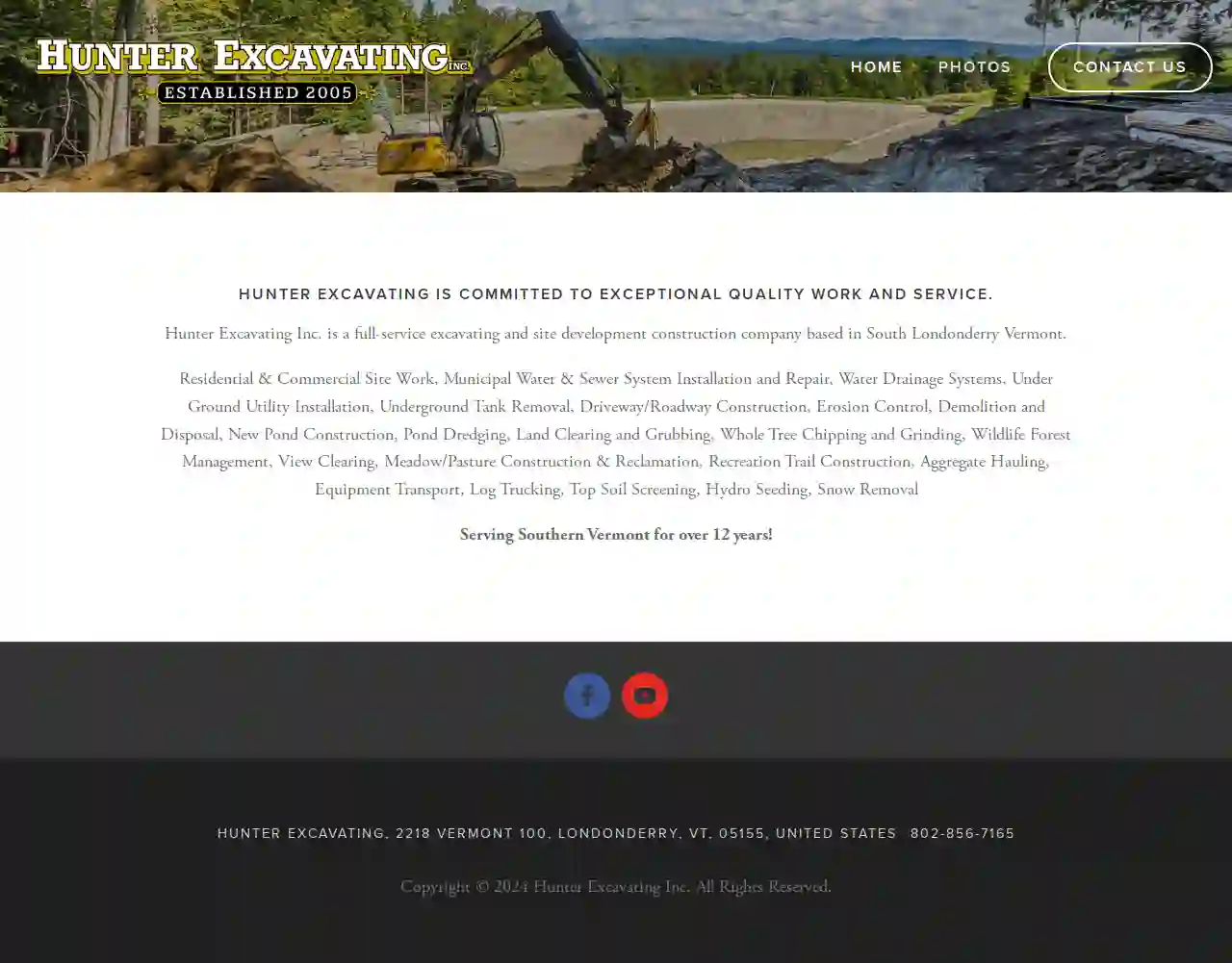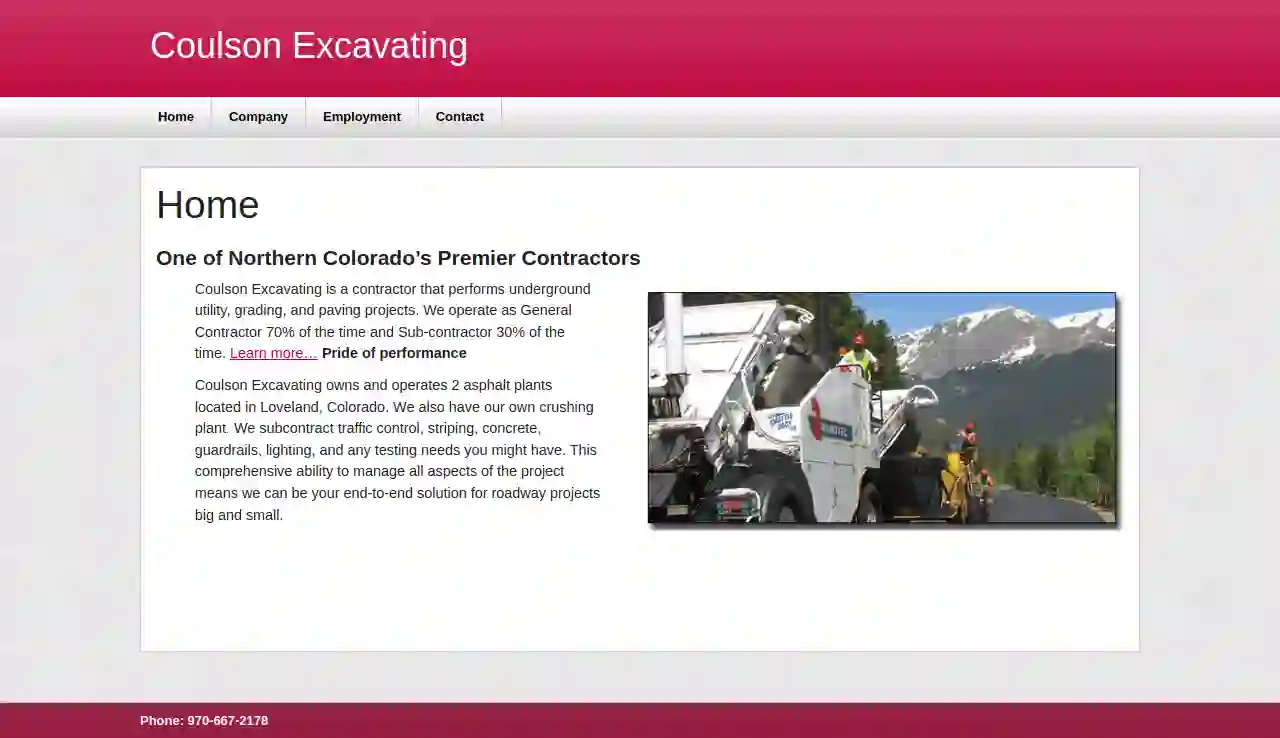Demolition Contractors Sterling
Find the best Local Demolition Contractors in Sterling
Receive 3 FREE Demo Companies quotes for your project today! Compare profiles, reviews, accreditations, portfolio, etc... and choose the best deal.

Colorado Hydrovac
423 25th Street, Greeley, 80631, USColorado Hydrovac and Environmental Services offer a wide variety of Hydro Excavating, and Construction Services. Ryan and Scott’s combined experience ensures each client receives the safest work practices, and ensures each job is done correctly and efficiently every time. Whether your job is large or small, call Tri-State Construction today for prompt, professional service. In addition to our Hydrovac excavation services, our construction division Tri-State Construction expands our offerings to better serve our clients throughout Colorado and surrounding states.
- Services
- Why Us?
- Gallery
Get Quote
chuckEX
4.79 reviewsBoulder, USAbout Us chuckEX was born out of a love of moving earth, big toys and a disdain for the ethics of many of the contractors who run them. Put simply, we enjoy what we do and we will do what we can to make it enjoyable for you as well. Our commitment is to be transparent with our customers about what we are doing and to bring to light the risks and costs involved. We strive to set expectations properly at the beginning, under-promise and over-deliver. Doing our best to expose possible surprises at the beginning of the project so that our customers have a clear picture of what the project entails. We want to take the anxiety out of excavation!
- Services
- Why Us?
- Testimonials
- Gallery
Get Quote
Colorado Excavating, Inc.
52 reviewsDenver, USAbout Us Colorado Excavating is your full-service excavating company, serving the Colorado Springs and Denver areas. We are experts in all your excavation needs, from basement and foundation digs to backfill and compaction, retaining wall engineering and building, and drainage contracting. We have the experience to meet your needs and provide comprehensive excavation, grading, and land development services. We understand that excavation is a crucial part of any land development project, as it lays the foundation for everything that comes next. That's why it's vital to choose a local excavation contractor with solid experience and quality workmanship. When you hire Colorado Excavating, you benefit from our years of experience and our commitment to customer satisfaction. We stand behind our services with a guarantee of satisfaction. As a family-owned and family-operated business, we take pride in our quality of service. Whether you need basement excavation, septic system replacement, or ditches dug for water or gas lines, we have the equipment and expertise to meet all your needs. Call us today for a free estimate!
- Services
- Why Us?
- Gallery
Get Quote
Havreluk Construction
Fairfax, VT, 05454, USHavreluk Construction, LLC is a residential and commercial excavating contractor in Vermont. We specialize in a wide range of services, including complete lot clearing, septic installations, water lines, pools, garages, ponds, road building, stump removal, underground utilities, cellar holes, back filling, hauling of loam, sand, gravel, stone, lawn seeding, and more! We are committed to providing our clients with high-quality workmanship and exceptional customer service. Our team of experienced professionals is dedicated to exceeding your expectations on every project. Whether you're a homeowner looking to improve your property or a business owner in need of excavation services, Havreluk Construction, LLC is the right choice for you. Contact us today to discuss your project and get a free estimate.
- Services
- Why Us?
- Gallery
Get Quote
Hunter Excavating Inc.
4.611 reviews2218 Vermont 100, Londonderry, 05155, USHunter Excavating is committed to exceptional quality work and service. Hunter Excavating Inc. is a full-service excavating and site development construction company based in South Londonderry Vermont. We offer a wide range of services for both residential and commercial clients, including: Residential & Commercial Site Work Municipal Water & Sewer System Installation and Repair Water Drainage Systems Under Ground Utility Installation Underground Tank Removal Driveway/Roadway Construction Erosion Control Demolition and Disposal New Pond Construction Pond Dredging Land Clearing and Grubbing Whole Tree Chipping and Grinding Wildlife Forest Management View Clearing Meadow/Pasture Construction & Reclamation Recreation Trail Construction Aggregate Hauling Equipment Transport Log Trucking Top Soil Screening Hydro Seeding Snow Removal Serving Southern Vermont for over 12 years!
- Services
- Why Us?
- Gallery
Get Quote
Boulder Excavating LLC
1630 30th St #234, Boulder, 80301, USWelcome to Boulder Excavating Pros YOUR TRUSTED EXCAVATING AND LANDSCAPING CONTRACTOR IN BOULDER CO Finding the right contractor for your project can be difficult. Good contractors should have the capability to provide high-quality work and a wide range of services while controlling the costs, quality, and timing. Trust us to get the job done! OUR MISSION At Boulder Excavating Pros, we put our emphasis on helping our customers build the perfect project for their specific needs. We tackle each project with care and with a focus on open communication and getting the job done right the first time. HIGHLY-QUALIFIED PROFESSIONALS Our professionals have over 20 years of experience working with residential, commercial, and industrial projects of all sizes across the country. We know the job and we can work with you to build an excellent project that lasts a lifetime. TOP-QUALITY EQUIPMENTS & TECHNOLOGY At Boulder Excavating Pros, we only use top-quality construction equipment and industry-leading technologies. For over 20 years, we’ve been working hard to earn a reputation for quality and work ethics. Contact us today to make your dream project come true! Over 20 Years Reputation for Excellence We will make it easy for you throughout the construction process. From Planning and Design, to Preconstruction, Construction and Project Management, we tackle each project with care and with a focus on open communication and getting the job done right the first time. PROFESSIONAL MANAGEMENT TEAMS PRECISION EXCAVATION SERVICES EXPERT WORKMANSHIP & TOP MATERIALS
- Services
- Why Us?
- Testimonials
- Gallery
Get Quote
Coulson Excavating Co
3.117 reviewsLoveland, USAbout Coulson Excavating Coulson Excavating was established in Loveland, Colorado in 1949 by C.H. Coulson. The company's success and longevity have always been rooted in its commitment to delivering top-quality work and its ability to handle complex asphalt and excavation projects. Today, the company is owned and operated by C.H. Coulson's son and grandson, Richard and Ken Coulson. Our Promise When you work with Coulson Excavating, you can be confident that you're collaborating with a professional, experienced team dedicated to your satisfaction. With crews specializing in pipe work, dirt work, crushing, and two asphalt facilities, we're equipped to handle projects of any size. Our Partners While Coulson Excavating doesn't perform bridge or concrete work, we have long-standing partnerships with reputable companies to ensure a seamless experience for your project. We subcontract traffic control, striping, concrete, guardrails, lighting, and testing. We are also active members of the Colorado Asphalt Pavement Association (CAPA) and the Colorado Contractors Associations (CCA). Our Range Although we don't have fixed territorial boundaries, Coulson typically operates in areas ranging from DIA north to the Wyoming border and from the Nebraska border west to Steamboat Springs.
- Services
- Why Us?
- Gallery
Get Quote
Atlas Excavating Inc
4.612 reviewsLafayette, USEXCAVATING EXCELLENCE When you have public, commercial or private utility work that needs to be done quickly with quality and safety in mind, look no further than Atlas Excavating, Inc. We have the most highly-trained, union Laborers and Operators with years of experience working for both public and private clients. Work We Do Atlas performs all aspects of site-civil construction and earthwork for industrial, institutional, commercial, and residential sites including: Sanitary Sewer Storm Sewer Water Main Force Main De-watering Site Excavation GPS Site Grading Lift Stations Low Pressure Sewer Success Is In the Details Project success is in the details. We provide the services and information for transparent and successful completion. Project budgets Value engineering Electronic project submittal/tracking using Procore Earthwork takeoffs using AGTEK GPS grading Drone verification of existing surfaces and project progress Detailed scopes of work built to the customers needs and requests WHERE WE WORK Whatever your project, we have the experience, equipment, and newest technology to accurately assess your excavation needs, document the process, and complete with upmost precision. Multiple Crews Highly Resourced Union Contractor Low EMR Safety Culture Financially Stable 35 Years of Deep Sewer Experience Our Portfolio is Second to None Every excavation job is different, and each has its unique challenges. The collective experience of our laborers and operators is so broad that they're equipped to handle any challenge that could possibly pop up on the job site. Whether you have us excavating an entire shopping mall from scratch or need a repair of existing sewer system in a storm, we bring the best practices and industry knowledge with us to every job. We've worked with all the big commercial builders and are a highly sought after subcontractor for commercial jobs ranging from the huge to the boutique. Our private track record is just as impressive. We have literally hundreds of satisfied customers whose trust we've earned with quality work and the highest levels of professionalism. OUR PROVEN PROCESS At Atlas we change the perception of construction by building with integrity and treating everyone like family. Meet With Customer Discuss Core Values of Each Company Determine Goals of Relationship (Shared Risk Concepts) Establish Routine for Relationship (Hard Bid, Unit Price, Lump Sum, Cost Plus) Terms and Conditions Establish Scope of Work Prepare Pricing Options / Value Engineering Considerations Drone Earthwork Balance Verification Review Scope and Pricing Value Engineering / Scope Adjustments Establish Contract Value and Final Scope Establish Finance / Payment Terms Project Management Team Takes Over Documentation - Drone Flight, Video All Contract Documents Loaded to Procore for Owner Communication Electronic RFI Process Change Orders Will Be Agreed to Prior to Construction Electronic as Builts Monthly Billings and Lien Releases
- Services
- Why Us?
- Gallery
Get Quote
Earthworx Excavation
4.413 reviewsMontrose, CO, USEarthworx Excavation: Your Trusted Partner for Excavation Services Earthworx Excavation is a family-owned and operated company in Montrose, Colorado, serving the Western Slope with over 60+ years of experience in Residential and Commercial Excavation Services. We are committed to providing our clients with the highest quality services, delivered with honesty, integrity, and a dedication to safety. Our Values Drive Your Success At Earthworx Excavation, we believe in building strong relationships with our clients, based on trust, transparency, and a shared commitment to excellence. Our core values guide everything we do: Integrity Always: We operate with the highest ethical standards, ensuring that our actions are always in the best interest of our clients, the environment, and our team. Safety For All: The safety and well-being of our team, our partners, and the public is our top priority. We maintain strict safety standards on every job site. Excellent Craftsmanship: We are dedicated to providing high-quality construction at competitive prices. We strive to understand our clients' needs and work collaboratively to make their vision a reality. Experience the Earthworx Difference We are proud to be a diverse, multi-dimensional company that is fully insured and licensed. We take pride in our ability to adapt to a dynamic marketplace and continue to remain proactive in an ever-changing economic environment, with the goal in mind to continue to improve in order to better service our clients while preserving our competitiveness in the marketplace. Creating an outstanding product at a competitive price Nurturing high standards of skill and integrity in our team members A dedication to the safety of our staff A commitment to ecologically friendly construction Environmentally Conscious Earthworx Excavation is proud of its recycling efforts and our role in preserving landfills and the environment. We are very conscious of the fact that what we do as a company today affects our community tomorrow. Earthworx Excavation strives to be an industry leader in environmentally friendly practices.
- Services
- Why Us?
- Accreditations
- Gallery
Get Quote
Dirt Dogs Excavating, Grading, and Land, LLC
4.911 reviewsElizabeth, Colorado, USWelcome to Dirt Dogs Grading & Land LLC A Professional Excavating and Grading Company Dirt Dogs Excavating is a professional excavating and grading company committed to excellence and offering both commercial and residential excavation, grading and trenching services. Whether you need excavation, earth moving or foundation excavation for a new home, horse barn or arena, driveway, road grading or landscaping project, our qualified personnel recognize the importance of completing a quality project on time and on budget. This is achieved with our constant attention to detail and our dedication to getting the job done right. We build enduring relationships with our clients through honest communication, trust and reliability. We serve clients from Elizabeth, Franktown, Parker, Castle Rock, Colorado and surrounding areas.
- Services
- Why Us?
- Testimonials
- Gallery
Get Quote
Over 22,076+ Excavation Pros registered
Our excavation contractors operate in Sterling & surrounding areas!
ExcavationHQ has curated and vetted the Best Excavation Contractors in Sterling. Find the most reliable contractor today.
Frequently Asked Questions About Demolition Contractors
- Site Security: Secure the demolition site with fencing and warning signs to prevent unauthorized access.
- Personal Protective Equipment (PPE): Workers should wear appropriate PPE, including hard hats, safety glasses, gloves, and steel-toe boots.
- Hazardous Material Removal: Properly identify and remove asbestos, lead paint, or other hazardous materials before demolition begins.
- Utility Disconnections: Disconnect all utilities, such as electricity, gas, and water, before demolition.
- Controlled Demolition Techniques: Employ controlled demolition methods to minimize risks and ensure the structure comes down safely.
- Dust Control: Implement dust suppression measures, such as water spraying or misting, to reduce airborne particles and protect air quality.
- Emergency Planning: Have an emergency plan in place, including communication protocols and evacuation procedures, in case of unforeseen events.
- Implosion: Using explosives to collapse a structure inwards rapidly. Suitable for large buildings in open areas.
- Wrecking Ball: Swinging a large steel ball to impact and break down the structure. Effective for bringing down walls and other solid elements.
- High-Reach Demolition: Utilizing specialized excavators with extended arms and demolition attachments for dismantling tall structures piece by piece.
- Selective Demolition: Removing specific parts of a building while preserving other sections. Often used in renovation projects.
- Deconstruction: Carefully dismantling a building to salvage reusable materials, reducing waste and environmental impact.
What is a demolition bond?
What are the safety precautions for demolition?
Can I do demolition myself?
What are the different types of demolition?
What is a demolition bond?
What are the safety precautions for demolition?
- Site Security: Secure the demolition site with fencing and warning signs to prevent unauthorized access.
- Personal Protective Equipment (PPE): Workers should wear appropriate PPE, including hard hats, safety glasses, gloves, and steel-toe boots.
- Hazardous Material Removal: Properly identify and remove asbestos, lead paint, or other hazardous materials before demolition begins.
- Utility Disconnections: Disconnect all utilities, such as electricity, gas, and water, before demolition.
- Controlled Demolition Techniques: Employ controlled demolition methods to minimize risks and ensure the structure comes down safely.
- Dust Control: Implement dust suppression measures, such as water spraying or misting, to reduce airborne particles and protect air quality.
- Emergency Planning: Have an emergency plan in place, including communication protocols and evacuation procedures, in case of unforeseen events.
Can I do demolition myself?
What are the different types of demolition?
- Implosion: Using explosives to collapse a structure inwards rapidly. Suitable for large buildings in open areas.
- Wrecking Ball: Swinging a large steel ball to impact and break down the structure. Effective for bringing down walls and other solid elements.
- High-Reach Demolition: Utilizing specialized excavators with extended arms and demolition attachments for dismantling tall structures piece by piece.
- Selective Demolition: Removing specific parts of a building while preserving other sections. Often used in renovation projects.
- Deconstruction: Carefully dismantling a building to salvage reusable materials, reducing waste and environmental impact.